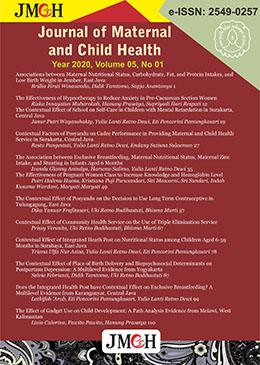Contextual Effect of Community Health Service on the Use of Triple Elimination Service
Abstract
Background: Triple elimination is the elimination of transmission of HIV, syphilis, and hepatitis B from mother to child. The Prevention of Mother to Child Transmission (PMTCT) program is a comprehensive activity. The basic condition of the case is carried out because of the importance of health promotion and early detection in strategies for managing HIV, Syphilis, and Hepatitis B infections. This study aimed to analyzecontextual effect of community health service on the use of triple elimination service in pregnant women.
Subjects and Method: This was a cross sectional study conducted at 25 community health centers in Sragen Regency, Central Java, from June to July 2019. A sample of 200 pregnant women was selected by stratified random sampling. The dependent variable was the use of triple elimi
How to Cite
References
Abamecha F, Godesso A, Girma E (2013). Intention to voluntary HIV counseling and testing (VCT) among health professionals in Jimma zone, Ethiopia: The theory of planned behavior (TPB) perspective. BMC Public Health, 13(1): 1. doi: 10.1186/1471-2458-13-140 [Crossref] [PubMed] [Google Scholar]
Abolfotouh MA, Banimustafa AA, Mahfouz AA, Al-assiri MH (2015). Using the health belief model to predict breast self-examination among Saudi women. BMC Public Health, 1
Deo KK (2015). Barriers to utilization of antenatal care services in Eastern Nepal. Public Health Policy. 3:197. doi: 10.3389/fpubh.2015.00197 [Crossref] [PubMed] [Google Scholar]
Eluwa GI, Sylvia A, Luchters S, Ahonsi B (2015). HIV Risk Perception and Risk Behaviors among Men Who Have Sex with Men in Nigeria. J of AIDS Clinical Research 6: 478. doi: 10.4172/2155-6113.1000478 [Crossref] [Google Scholar]
Emdadi S, Hazavehie SM, Soltanian A, Bashirian S, Heidari MR (2015). Predictive factors of regular physical activity among middle-aged women in the West of Iran, Hamadan: Application of PRECEDE Model. J Res Health Sci. 15(4): 244-9. [PubMed] [Google Scholar]
Fauk, Nelsensius K, Sukmawati AS, Wardojo SSI, Teli M, Bere YK, Mwanri L (2018). The intention of men who have sex with men to participate in voluntary counseling and HIV testing and access free condoms in Indonesia. AJMH: 2:15579883187-79737. doi: 10.1177/1557988318779737 [Crossref] [PubMed] [Google Scholar]
Febres CB, Kimberly CB, Teresita RJ, Carmen FC, Sonia MM, Shira MG (2018). Influence of peer support on hiv/sti prevention and safety amongst international migrant sex workers: A qualitative study at the mexicoguatemala border. PLoS ONE. 13(1): 1
Gedefaw AA (2016). Determinants of voluntary HIV counseling and testing among Addis Ababa university students, Ethiopia. Global J. 16(2).
Gholami M, Jabbari A, Kavosi, Z, Gholami, M (2016). Service Quality in Iran
Kurniasari MA, Murti B, Demartoto A (2016). Association between participation in HIV/ AIDS peer group, stigma, discrimination, and quality life of people living with HIV/AIDS. J Epidemiol Public Healt. 1(2): 125-132. doi: 10.26911/jepublichealth.2016.01.02.06 [Crossref] [Google Scholar]
Lawrence W, Green Judith M, Ottoson. (2006). A framework for planning and evaluation: precede proceed evolution and application of the model. 10Es Ans J De Sante Publique: 1
Murti B (2018). Prinsip dan metode riset epidemiologi (5th ed.)
Nareswara A, Murad C, Afriandi I (2017). Health belief model theory application on voluntary counseling and testing among homosexual men in Bandung greater area. AMJ, 3(4): 595
Obermeyer, Carla M, Michelle O (2007). The utilization of testing and counseling for HIV: A review of the social and behavioral evidence. AJPH. 97(10): 176-274. doi: 10.2105/ajph.2006.096263 [Crossref] [PubMed] [Google Scholar]
Peraturan Menteri Kesehatan Republik Indonesia Nomor 75. (2014). Pusat Kesehatan Masyarakat [Website]
Perdana MV, Demartoto A, Indarto D (2017). Effects of predisposing, enabling, and reinforcing factors on the uptake of voluntary counselling and testing among female sex workers in Grobogan, Central Java. ICPH. 172: 243
Pharr JR, Nancy LL, Echezona EE (2016). Barriers to HIV testing among young men who have sex with men (MSM): Experiences from Clark County, Nevada. 8 (7):9
Pinar Y, Oztunc G, Zehra E, Gulsah T, Kose I (2015). An Investigation of Patients' Perceptions of Nursing Care: Case of Intensive Care. IJCS 8(2): 412. [Website]
Putri SDK, Christiani N, Nirmasari C, (2015). Hubungan Usia Ibu Hamil dengan Kepatuhan ANC di Puskesmas Suruh Kabupaten Semarang. Jurnal Keperawatan Maternitas: 33-41. [Website]
Qiao S, Yao ZH, Xiaoming L, Anitha ML (2018). Facilitators and barriers for HIV-testing in Zambia: A systematic review of multilevel factors. PLoS ONE. 1
Rahmadani S, Muh S, Alwy A (2014). The analysis of factors affecting the use of VCT service for high-risk group infected with HIV/ AIDS in Makassar. IJRHS. 4:1097
Kementerian RI (2017). Data dan Informasi Profil Kesehatan Indonesia (Data and Information Indonesia Health Profil). Profil kesehatan Indonesia: 1
Satwika, Pertiwi NKD, Wulandari NMK. (2018.) Pengaruh Orientasi Pasar Serta Inovasi Terhadap Keunggulan Kompetitif Dan Kinerja Bisnis. E-Jurnal Manajemen Unud, 7(3): 1481-1509. [Google Scholar]
Schnall R, Rojas M, Travers J (2015). Understanding HIV testing behaviors of minority adolescents: A health behavior model analysis. JAN in AIDS Care. 26 (3):246
Sumarni (2017). Analisis Implementasi Patient Safety Terkait Peningkatan Mutu Pelayanan Kesehatan di Rumah Sakit. IJNP. 5(2): 91
Tarkang EE, Zotor FB (2015). Application of the Health Belief Model (HBM) in HIV Prevention: A Literature Review. Central African Journal of Public Health. 1(1): 1-8. [Google Scholar]










